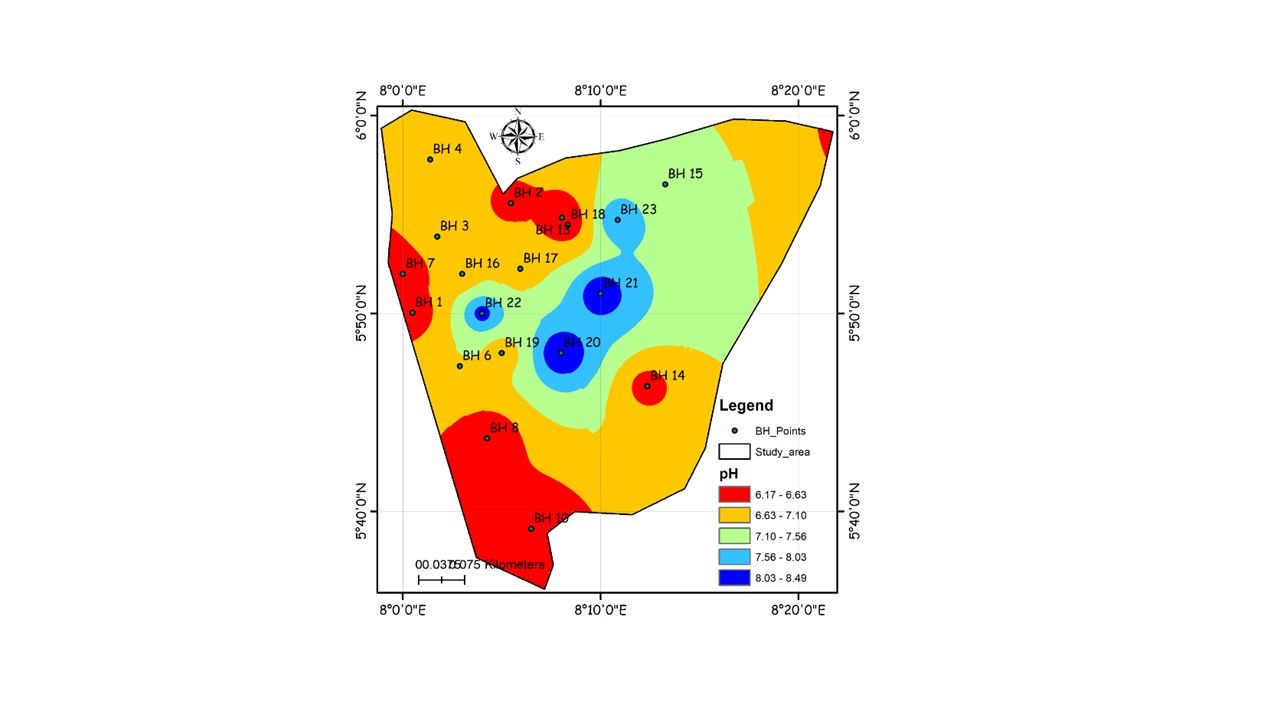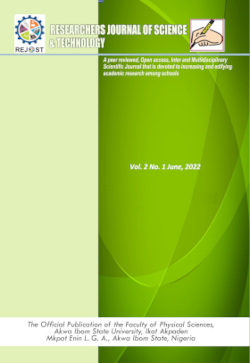Geochemical Analysis of Groundwater in Central Cross River State: Implications for Water Quality and Public Health
Keywords:
Groundwater quality, Hydrogeochemistry, Water contamination, Correlation matrix, Central Cross River State, Public health, Piper diagram, Water managementAbstract
Groundwater quality in Central Cross River State, Nigeria, is vital for public health and sustainability. This study evaluates the geochemical characteristics of groundwater in parts of the central Cross River State within the Ikom-Mamfe Embayment, analyzing physicochemical parameters, major ions, trace metals, and correlation matrix analysis. A total of 23 boreholes were sampled, revealing pH values between 6.17 and 8.50 (mean: 6.87) and electrical conductivity (EC) ranging from 28.67 to 198.50 µS/cm (mean: 133.43 µS/cm). Major anions include chloride (Cl⁻) at 0.25–5.10 mg/L (mean: 1.74 mg/L), fluoride (F⁻) at 0.03–0.21 mg/L (mean: 0.13 mg/L), nitrate (NO₃⁻) at 0.10–2.00 mg/L (mean: 0.91 mg/L), nitrite (NO₂⁻) at 0.01–1.10 mg/L (mean: 0.16 mg/L), and sulfate (SO₄²⁻) at 4.50–7.20 mg/L (mean: 5.85 mg/L), all within WHO limits. Major cations include calcium carbonate (CaCO₃) at 11.00–376.00 mg/L (mean: 134.71 mg/L), iron (Fe²⁺) at 3.05–6.23 mg/L (mean: 4.44 mg/L), magnesium (Mg²⁺) at 0.10–0.49 mg/L (mean: 0.16 mg/L), manganese (Mn²⁺) at 0.10–0.32 mg/L (mean: 0.16 mg/L), and sodium (Na⁺) at 1.10–1.41 mg/L (mean: 1.14 mg/L).Hydrogeochemical facies analysis (Piper and Durov diagrams) classifies groundwater as predominantly Ca-HCO₃ type, indicating carbonate dissolution as a key influence. Correlation matrix analysis revealed strong associations between EC and major cations/anions, highlighting mineral dissolution as a primary control on groundwater chemistry. Negative correlations between pH and Fe²⁺ (-0.453) and Mn²⁺ (-0.045) suggest that lower pH levels increase metal solubility, while positive correlations between turbidity and Fe²⁺ (0.354) indicate potential contamination sources. Elevated Fe²⁺ and Mn²⁺ concentrations exceed WHO drinking water guidelines, posing health risks. While groundwater remains largely suitable for irrigation, localized anthropogenic contamination from agriculture and waste disposal necessitates improved monitoring, pollution control, and targeted water treatment strategies. Sustainable groundwater management policies are essential to ensure long-term water safety in the region.
References
Akpan A. E, Ugbaja, A. N. & George, N. J. (2013) Integrated geophysical, geochemical and hydrogeological investigation of shallow groundwater resources in parts of the Ikom-Mamfe Embayment and the adjoining areas in Cross River State, Nigeria. Environ. Earth Sci, 70 (3). 1435–1456, Doi. 10.1007/s12665-0132232-3.
Akpan, A. E., Ugbaja, A. N., Okoyeh, E.I. & George, N.J, (2018), Assessment of spatial distribution of contaminants and their levels in soil and water resources of Calabar, Nigeria using geophysical and geological data, Environmental Earth Sciences, 77: 13,10.1007/s12665-017-7189-1
American Public Health Association (APHA). (2017). Standard Methods for the Examination of Water and Wastewater. Washington, D.C.: APHA.
Bassey CE, Eminue, O. O. & Ajonina HN (2013) Stratigraphy and depositional environments of the Mamfe formation and its implication on the tectono-sedimentary evolution of the Ikom-Mamfe Embayment, West Africa. Cent Eur J Geosci 5(3):349–406
Chen J, Gao Y, Qian H, Ren W. & Qu W (2021) Hydrogeochemical evidence for fluoride behavior in groundwater and the associated risk to human health for a large irrigation plain in the Yellow River Basin. Sci Total Environ 800:149428. https://doi.org/10.1016/j.scitotenv.2021.149428
Duoxun X, Peiyue L, Xin C, Shengfei Y. & Pei F. G. (2023) Major ion Hydrogeo-chemistry and health risk of groundwater nitrate in selected rural areas of the Guanzhong Basin, China. Hum Ecol Risk Assess Int J. https://doi.org/10.-1080/10807039.2022.2164246
Durov, S. A. (1948). Natural Waters and Their Evolution. Geological Review, 43, 23-31.
Ekanem, A. M., Akpan, A., George, N. J. & Thomas, J. E. (2021). Appraisal of protectivity and corrosivity of surficial hydrogeological units via geo sounding measurements. Environ Monit Assess, 193:718. https://doi.org/10.1007/-s10661-021-09518-9
Ekanem, A. M., George, N. J., Thomas, J. E.& Nathaniel, E. U. (2020). Empirical Relations Between Aquifer Geohydraulic – Geoelectric Properties Derived from Surficial Resistivity Measurements in Parts of Akwa Ibom State, Southern Nigeria. Natural Resources Research 29(4), 2635-2646. https://doi.org/10.1007/s11053-019-09606-1.
Ekanem, A. M., George, N. J., Thomas, J. E., Udo, I. G. (2024). Geophysical investigation of aquifer flow unit characteristics in northern parts of Akwa Ibom State, Southern Nigeria. Results in Earth Sciences, 2, 100017. https://doi.-org/10.1016/j.rines.2024.100017
Ekwere, A. S., & Ekwueme, B. N. (2016). Hydrogeochemical assessment of groundwater in Central Cross River State, Nigeria. Journal of African Earth Sciences, 117, 142-153.
Etesin, U. M, George, N. J, Ogbonna, I. J. & Akpan, I. O. (2023). Source Identification and Variation in the chemical Composition of Rainwater in the Coastal and Industrial Areas: A Case Study of Ikot Abasi, South-Eastern Nigeria. Earth Sciences, 7(1): 55-63.
Gandla, S., Umrikar, B., George, N.J. & Gupta, G. (2024) Geochemical assessment of groundwater quality for domestic, irrigation and industrial purposes: a tool for environmental monitoring and assessment in a semiarid region of eastern Maharashtra, India, Discover Water, https://doi.org/10.1007/s43832-024-00158-x
George, N. J., Ekanem, A. M., Thomas, J. E. & Ekong, S. A., (2021). Mapping depths of groundwater - level architecture: implications on modest groundwater -level declines and failures of boreholes in sedimentary environs. Acta Geophysica, 69: 1919–1932. https://doi.-org/10.1007/s11600-021-00663-w
George, N. J. & Thomas, J. E. (2023a) Typification of coastal depositional lithofacies with isophysical and isochemical hydro-sand beds via stratigraphic modified Lorenz plots (SMLP): geohydrodynamical implications and valorization of hydrogeological units. Acta Geophys. https://doi.org/10.1007/s11600-023-01160-y
George, N.J. & Thomas, JE. (2023b) Groundwater potential and quality assessments of a coastal environment: a case study of the location of Federal University of Technology Ikot Abasi (FUTIA), Akwa Ibom State, Nigeria, Journal of Coastal Conservation, 27 (4), https://doi.org/10.1007/s11852-023-00956-w
Hem, J. D. (1985). Study and Interpretation of the Chemical Characteristics of Natural Water. U.S. Geological Survey Water-Supply Paper 2254.
Ibanga Jewel I. & George N. J., (2016) Estimating geohydraulic parameters, protective strength, and corrosivity of hydrogeological units: a case study of ALSCON, Ikot Abasi, southern Nigeria, Arabian Journal of Geosciences, 9(5), 1-16.
Ibuot, J. C., Okeke, F.N, George, N.J & Obiora, D. N. (2017), Geophysical and physicochemical characterization of organic waste contamination of hydrolithofacies in the coastal dumpsite of Akwa Ibom State, southern Nigeria, Water Science & Technology: Water Supply, 17 (6): 1626-1637, doi: 10.2166/ws.2017.066.
Inim I. J., Udosen N. I., Tijani M. N., Afia U. E., George N. J. (2020). Time‑lapse electrical resistivity investigation of seawater intrusion in coastal aquifer of Ibeno, Southeastern Nigeria, Applied Water Science, Germany, 10, 232 (2020), https://doi.org/10.1007/s13201-020-01316-x
Inyang, N.E, George, N.J., Ehibor, I.U., Ekot, A.E.& Udoh, I.G. (2023). Integrated valorization of MSW incursion into water resources: a tool for environmental monitoring and assessment near dumpsite areas, Akwa Ibom State, Nigeria. https://doi.org/10.21203/rs.3.rs-3492331/v1
Obiora, D. N., Ibuot, J. C., George, N. J., & Offiah, S. U. (2016). Delineation of groundwater saturation indicators and their distributions in the complex argillaceous geological units of Ezza north local government area of Ebonyi state, Nigeria. Current Science, 110(4), 701 – 708
Odong, P.O., Ebong, E.D., Awak, E.A., Ojong, R.A. & Umera, R.B. (2024) Integrated geophysical and hydrogeochemical characterization of groundwater vulnerability conditions in part of Ikom-Mamfe Embayment, southeastern Nigeria. Sustain. Water Resour. Manag. 10, 120. https://doi.org/10.1007/s40899-024-01094-3
Okon, E. B., Udo, I. A., & Udoh, P. D. (2018). Groundwater geochemistry and contamination assessment in Ikom-Mamfe Embayment, Nigeria. Environmental Geochemistry and Health, 40(5), 2101-2116.
Piper, A. M. (1944). A Graphic Procedure in the Geochemical Interpretation of Water Analyses. Transactions of the American Geophysical Union, 25, 914-928.
Sikakwe G. U. & Eyong, G.A. (2022) Groundwater flow and geochemical processes affecting its quality in the basement (Oban Massif) and sedimentary (Mamfe Embayment) environments, southeastern Nigeria, Journal of African Earth Sciences, 188, https://doi.org/10.1016/j.jafrearsci.2022.104467
Thomas, J. E. George, N. J. & Ekanem, A. M. & E. E. Nsikak (2020). Electrostratigraphy and hydrogeochemistry of hyporheic zone and water-bearing caches in the littoral shorefront of Akwa Ibom State University, Southern Nigeria, Environ. Monit Assess., 192 (8) 1-19 https://doi.org/10.1007/s10661-020-08436-6
Udosen, N. I., Ekanem, A. M.& George N. J. (2024). Appraisal of Flood-Prone Litho-Stratigraphic Units Via Geo-Electrical Technology. Malaysian Journal of Geosciences (MJG), 8(1) (2024) 26-37. DOI: http://doi.org/10.26480/mjg.01.2-024.26.37
Uka, N. K., Nfor, B., & Eze, E. O. (2019). Isotopic and hydrogeochemical characteristics of groundwater in Southeastern Nigeria. Hydrology Journal, 8(2), 78-92.
Umoh, J. A., George, N. J., Ekanem, A. M., Thomas, J. E.& Emah, J. B. (2022a). Approximate delineation of groundwater yield capacity and vulnerability via secondary geo-electric indices and rock-water interaction hydrodynamic coefficients in a coastal environment. Researchers Journal of Science and Technology, 2(3): 28 – 54
Umoh, J. A., George, N. J., Ekanem, A.M. & Emah, J. B. (2022b). Characterization of hydro-sand beds and their hydraulic flow units by integrating surface measurements and ground truth data in parts of the shorefront of Akwa Ibom State, Southern Nigeria. Int. J. Energy Water Resources. https://doi.org/10.100-7/s42108-022-00215-y
World Health Organization (WHO). (2022). Guidelines for Drinking-Water Quality (4th ed.). Geneva: WHO.

Downloads
Published
How to Cite
Issue
Section
License
Copyright (c) 2025 Researchers Journal of Science and Technology

This work is licensed under a Creative Commons Attribution-NonCommercial-NoDerivatives 4.0 International License.




